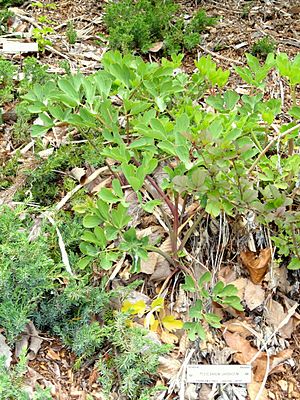Coastal hog fennel facts for kids
Quick facts for kids Coastal hog fennel |
|
|---|---|
 |
|
| Scientific classification | |
| Genus: |
Peucedanum
|
| Species: |
japonicum
|
Peucedanum japonicum, often called coastal hog fennel, is a type of plant. It belongs to the Peucedanum group, which is known for many plants used in medicine. This plant is part of the parsley family, called Apiaceae.
Contents
About the Plant's Name
The plant Peucedanum japonicum was first officially described by a scientist named Thunberg in 1784.
What the Plant Looks Like
Peucedanum japonicum is a strong plant that usually grows between 30 and 100 centimeters tall. It has a thick stem and is mostly smooth.
Its leaves are shaped like a wide oval or triangle. They can be about 35 by 25 centimeters in size. The leaves are a bit leathery and often divided into three parts. These leaf parts are round or oval, about 7–9 centimeters wide, and have a slightly blue-green color.
The plant produces flower clusters that look like umbrellas, called umbels. These clusters are 4–10 centimeters wide. Each cluster has 15 to 30 smaller stems, called rays, which hold the tiny flowers. The flowers can be purple or white.
After flowering, the plant produces small, oblong fruits. These fruits are about 6 by 4 millimeters and are a bit hairy, especially on their ridges.
Peucedanum japonicum flowers in June and July. Its fruits develop from August to September.
Where It Grows
This plant likes to live in areas near the coast and along seashores. You can usually find it in soil that is slightly acidic to mildly alkaline, at elevations below 100 meters.
Where It Is Found
Peucedanum japonicum grows in several places in Asia. You can find it in Chinese provinces like Fujian, Hong Kong, Jiangsu, Shandong, Taiwan, and Zhejiang. It also grows in Japan, Korea, and the Philippines.
How People Use It
Peucedanum japonicum is used in different ways, especially in cooking and traditional medicine.
In Korea
In Korea, this plant is often called bangpung (방풍) or bangpungnamul (방풍나물). Its official name is gaetgireumnamul (갯기름나물).
Korean people use the fresh leaves of coastal hog fennel as a wrap for food, like ssam vegetables. They also pickle the leaves in soy sauce and vinegar to make jangajji.
This plant can be a main ingredient in namul dishes, which are seasoned vegetable side dishes. It's also added as a herb to many other foods. These include soybean paste stew, starch jelly dishes, fritters, and pancakes. You might find it in noodle soups, dough soups, stir-fried glass noodles, or mixed with rice. Some even use it in Korean-style Italian dishes like lasagne.
-
Bangpungnamul-muchim (seasoned coastal hogfennel leaves)
-
Coastal hogfennel rice cakes for tteokguk (rice cake soup)
In Japan
In Japan, Peucedanum japonicum is known as the "longevity herb." People have believed for a long time that it has special health benefits. It's called chyou-mei-gusa, which means "grass for longevity."
This herb is served in traditional Japanese dishes during important ceremonies. For example, it's used during shirayoi, a naming ceremony for a newborn baby. It's also part of yahnuyoi, a celebration when a new house is finished.
Most of this herb in Okinawa comes from Yonaguni Island. It could become another important plant for Okinawa, like turmeric and aloe. Some companies, like Shiseido, sell Peucedanum japonicum as a health food in tablets, powder, and drinks.
People in Okinawa are known for living longer and having lower rates of certain illnesses. Some believe this is partly because of what they eat, including plants like Peucedanum japonicum. In ancient times, people in the Ryūkyū Islands used the leaves and roots of this plant to treat sore throats.
In China
In China, Peucedanum japonicum is called bin hai qian hu (滨海前胡). It was also known by an older name, fang kui (防葵).
This plant is used for both cooking and traditional medicine in China. It is thought to help the body get rid of waste, act as a diuretic, help with coughs, and have a calming effect. It is also considered a tonic, which helps the body feel stronger.
Scientists have studied this plant, for example, in mice. They found that it might help prevent weight gain from a high-fat diet. This could be because it contains natural chemicals that might stop the body from absorbing too much fat.



